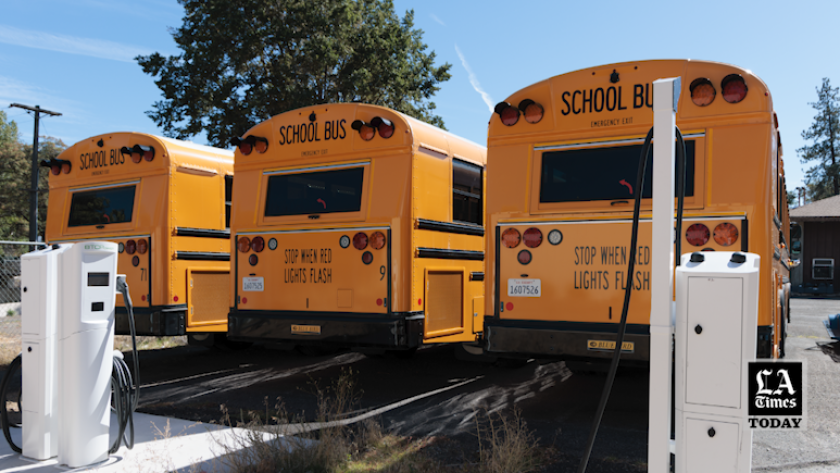Boiling Point: Which cities are taking charge as California shifts to electric buses?

Hi everyone, my name is Tony Briscoe. I’m the Los Angeles Times’ air quality and environmental health reporter. I’m filling in for Sammy Roth in this week’s edition of Boiling Point.
If you’re like me and live near a bus stop, you’ll hear a natural gas-powered bus go by roughly every 10 to 15 minutes. This public transit is necessary to curb the miles we drive.
But most of these buses still burn natural gas or diesel for fuel, which releases smog-forming air pollution and planet-warming carbon dioxide.
Times Sacramento bureau chief Laurel Rosenhall and I decided to dig a little deeper into California’s goals for electric buses when Gov. Gavin Newsom and members of his staff traveled to China in October to advance clean energy partnerships.
She shadowed Newsom when he visited a bus depot in Shenzhen, which in 2018 became the first city in the world with an all-electric bus fleet. Newsom walked inside several electric bus models parked at the depot and marveled at the long row of charging stations that spanned the parking lot, Rosenhall reported.
“We’re here because of the scale and scope,” Newsom said to the Chinese media that gathered around him at the bus depot. “You guys are doing things at a level that is not being done anywhere else on the globe.”
California is working on shifting public transit fleets to zero-emission buses by 2040. Although some agencies have had success transitioning their fleets, others are lagging behind due to hefty price tags attached to electric buses.
“We need to move fast, and we need to move at scale,” Newsom said in Shenzhen. “I’m here because that’s what you do best.”
Last year, the Antelope Valley Transit Authority, an agency that serves 450,000 residents in northern Los Angeles and southeastern Kern counties, followed Shenzhen to become the first agency in North America to go all-electric.
After conducting a pilot program to verify if electric buses could withstand the harsh conditions of the high desert, Antelope Valley transitioned its entire fleet of 86 buses in five years.
The agency accomplished this remarkable transition 28 years ahead of the Biden Administration’s goal of 2050 and 18 years ahead of California’s 2040 target.
The transition to electric buses, the agency said, has reaped economic and public health benefits.
So far, Antelope Valley’s zero-emissions fleet has traveled over 7 million miles and avoided burning 1.75 million gallons of diesel fuel. As a result, it has reduced its carbon emissions by 41.58 million pounds and released 130,900 pounds less lung-aggravating particulate matter.
Shenzen and Antelope Valley — two communities continents apart — shared at least one thing in common. Both had help from a local business.
BYD, the world’s largest electric vehicle manufacturer, is headquartered in Shenzhen. Lancaster, Antelope Valley’s largest city, is home to a 550,000-square-foot BYD manufacturing plant.
In a region that has been known as a bastion of Republican votes, the transit agency’s decision to purchase electric buses enjoyed bipartisan support because it also supported local jobs, according to environmental advocates.
“Sometimes we view these electric transportation issues as partisan, and they’re not,” said Adrian Martinez, a senior attorney with Earthjustice, an environmental nonprofit headquartered in San Francisco.
“In California, our leading transit agency [Antelope Valley] isn’t a bastion of liberal politics; it’s a relatively conservative community in the high desert,” he said. “So I think what it shows is electric buses are quiet, they’re clean, they save money. Those are values that don’t have a political party.”
There are 200 public transit agencies in California. They collectively operate roughly 12,000 buses statewide. By gradually transitioning these fleets to zero-emission buses, air regulators have estimated the state can reduce 19 million metric tons of carbon emissions — roughly the same as five coal-fired power plants operated for one year.
Although these emissions pale in comparison to heavy-duty trucks, environmental advocates argue bus fleets will likely pave the way for that transition.
“Throughout the history of cleaner vehicles, transit buses have often been kind of tip of the spear for technological breakthroughs in larger vehicles,” Martinez said. “A lot of the cleaner engine technologies we see in trucks today, those were first pioneered and developed in transit buses.”
And because these transit agencies are public, this information will likely be shared more openly to others that may want to replicate these emissions reductions.
“FedEx, UPS and other trucking companies are going benefit from what Antelope Valley’s done and what L.A. Metro’s doing on the electrification of its fleet,” Martinez said.
Three major Southern California transit agencies remain committed to having an all-electric fleet by 2030, a decade earlier than the state requirement. Here’s how they are progressing.
- Santa Monica’s Big Blue Bus service has 19 electric GILLIG buses in a 195-bus fleet.
- Long Beach Transit has 44 battery-electric buses, a mix of BYD and New Flyer models, in a fleet of 250.
- Los Angeles Department of Transportation has 48 electric buses, made by Proterra and BYD, in a fleet of about 400 buses.
Foothill Transit, which serves 22 cities in the San Gabriel and Pomona valleys, has retracted its commitment to go all-electric by 2030. But agency officials say they remain committed to meeting the state’s 2040 requirement.
L.A. Metro is “currently reviewing” the agency’s 2030 goal, which was contingent on cost and performance. The agency has 45 electric buses in service, a combination of New Flyer and BYD buses.
You're reading Boiling Point
Sammy Roth gets you up to speed on climate change, energy and the environment. Sign up to get it in your inbox twice a week.
You may occasionally receive promotional content from the Los Angeles Times.
On that note, here’s what’s happening around the West:
TOP STORIES
Global fossil fuel emissions grew 1.1% this year as the world released 36.8 billion metric tons of carbon dioxide. The rise in planet-warming gases arises from an uneven response by nations who have pledged to drastically slash their carbon footprint to meet international climate goals, reports Associated Press science reporter Seth Borenstein. China and India were responsible for the largest gains in carbon emissions. Meanwhile, the United States and Europe saw decreases in carbon emissions due, in part, to burning less coal.
World leaders gathered in Dubai for COP28, a United Nation’s summit, to discuss international efforts to mitigate the effects of climate change. But the event has been mired in controversy as scientists continue to contend with climate denialism, according to the New York Times. The president of the event — a Saudi oil executive — drew widespread criticism when he said it was not necessary to stop burning fossil fuels to prevent global warming. (He’s since walked back those comments.) Fossil fuel lobbyists have also turned out in record numbers.

Los Angeles County adopted its first water plan, aiming to dramatically reduce its dependence on imported water. The county plan calls for sourcing 80% of its water from local sources by 2045, my colleague Jaclyn Cosgrove writes. This strategy will involve higher rates of conservation, in addition to capturing stormwater and recycling wastewater. If successful, the plan hopes to collect billions of gallons of water over the next two decades.
THE ENERGY TRANSITION
Landscaping businesses are preparing for all-electric equipment rules to begin next year in California. A state law phasing out gasoline-powered landscaping equipment, including leaf blowers and lawnmowers, will go into effect next year, requiring professionals to switch to zero-emissions models. The legislation is intended to reduce smog-forming pollution, but some businesses have expressed concerns with the performance of battery-powered equipment, via Julie Johnson, environment reporter for the San Francisco Chronicle.
Mexican restaurants in Sacramento are contemplating whether to electrify their kitchens. Cooking with gas stoves has been a mainstay for many traditional Mexican restaurants across California. But Sacramento’s Northgate neighborhood may be at the forefront of a culinary shift. New grant funding is available to aid restaurants that decide to switch to electric appliances, writes Benjy Egel, Sacramento Bee food reporter. Although the switch would reduce cancer-causing pollution in the kitchen, the question is whether chefs can preserve the flavor of traditional cuisines.
Solar companies say California’s metering rules are limiting new installations. Last year, the California Public Utilities Commission revised net energy metering rules, slashing the value of electricity generated by rooftop solar panels by 75%, according to KPBS environment reporter Erik Anderson. This amendment has resulted in a significant drop in solar panel sales, pushing some companies to lay off employees and downsize their operations. Critics say the revised rules negatively impact the economics of solar power installation and could hinder California’s ambitious climate goals.
POLITICAL CLIMATE
Vice President Kamala Harris pledged $3 billion in U.S. aid will support developing nations to take climate action. These funds are expected to finance clean energy projects and efforts to build climate resiliency, according to Reuters’ Nandita Bose and Valerie Volcovici. However, the distribution of these funds are subject to Congressional approval.
The Norwegian government struck a deal to open parts of the Arctic Ocean for seabed mineral exploration, creating an opening for deep-sea mining. Although proponents say this could lend itself to extracting metals and minerals that are essential for making batteries and wind turbines, environmental groups are concerned about sea life, according to the Associated Press.
AROUND THE WEST

A controversial plan to eradicate non-native deer on Santa Catalina Island has pitted locals against conservationists. The Catalina Island Conservation, an environmental nonprofit, has proposed dispatching sharpshooters in helicopters to eliminate thousands of mule deer, which it claims threaten the ecosystem. But Times environmental reporter Louis Sahagún reports that many locals view the effort as a merciless slaughter. The clash has escalated into a series of personal attacks, threats and even a suspicious package left for conservationists.
Heavy groundwater use may not be necessary to grow crops in some parts of California. Times water reporter Ian James spent time with a longtime apple farmer who has broken the mold and does not irrigate his orchard. The technique, known as dry farming, traces its roots back to Indigenous peoples, including the Hopi, who thrived in the arid climate in the West. It demonstrates an alternative way to cultivate crops that could save precious resources in regions facing water scarcity.
The Los Angeles City Council moved to ban some types of rodeo events. A city ordinance intends to prevent animals from being harmed by prohibiting bull riding, calf roping and steer wrestling. However there are expected to be exceptions for some culturally significant equestrian traditions like charrería, Times reporter Susanne Rust and Dakota Smith write. The rule will be formally drafted by the city attorney before it returns to the city council for a final vote.
ONE MORE THING
As someone who grew up in Michigan, I couldn’t help but notice the recent news that the U.S. Fish and Wildlife Service recently announced it is adding wolverines to the list of species threatened with extinction. Over the years, they have been threatened by habitat loss from logging, poisonous traps set by farmers and loss of snow, Washington Post reporter Dino Grandoni writes.
The animal is much more than a mascot for the University of Michigan.
Michigan, itself, is nicknamed the Wolverine State because its residents were reminiscent of these tough animals. Although wolverines were never considered to be especially abundant in Michigan, I can remember the dismay when the state’s last known wolverine died in 2010. It’s a dire reminder of the threat posed by decades of inaction.
This column is the latest edition of Boiling Point, an email newsletter about climate change and the environment in California and the American West. You can sign up for Boiling Point here. And for more climate and environment news, follow @Sammy_Roth on X.
Watch L.A. Times Today at 7 p.m. on Spectrum News 1 on Channel 1 or live stream on the Spectrum News App. Palos Verdes Peninsula and Orange County viewers can watch on Cox Systems on channel 99.
Toward a more sustainable California
Get Boiling Point, our newsletter exploring climate change, energy and the environment, and become part of the conversation — and the solution.
You may occasionally receive promotional content from the Los Angeles Times.





